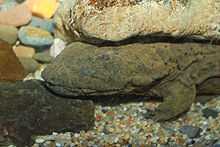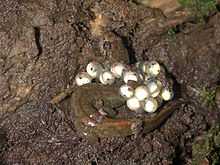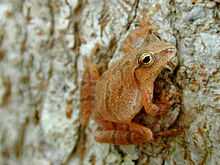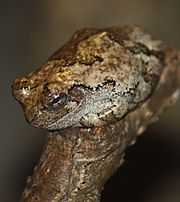List of amphibians of West Virginia








48 species of amphibians (class Amphibia) are known to inhabit the state of West Virginia. The ranges of some 34 salamander species and 14 species of frogs and toads extend into some portion of the state. Two of these — the Cheat Mountain salamander and West Virginia spring salamander — are endemic to West Virginia; they are the only vertebrate species found only within the state. The former species is considered threatened and the latter is considered endangered by federal authorities. Many of West Virginia's amphibian species are declining in population due to habitat destruction and water pollution.[1]
The IUCN classifies six species as "Near Threatened" (Eastern Hellbender,[2] Streamside Salamander,[3] Shenandoah Mountain Salamander,[4] Cheat Mountain Salamander,[5] Cow Knob Salamander,[6] and Green Salamander[7]) and one species as "Endangered" (West Virginia Spring Salamander[8]).
The following letters indicate the likelihood of finding each animal in West Virginia:[9]
| C | Common | Can be commonly seen in suitable habitat within current range. |
| U | Uncommon | Seldom seen because habitat restricted and/or behavior secretive. |
| R | Rare | Not often present even in suitable habitat. |
Order Caudata (salamanders)
Family Cryptobranchidae (giant salamanders)
- Eastern hellbender (Cryptobranchus alleganiensis) C
Family Proteidae (mudpuppies)
- Common mudpuppy (Necturus maculosus) C
Family Ambystomatidae (mole salamanders)
- Jefferson salamander (Ambystoma jeffersonianum) U
- Spotted salamander (Ambystoma maculatum) C
- Marbled salamander (Ambystoma opacum) C
- Small-mouthed salamander (Ambystoma texanum) R
- Streamside salamander (Ambystoma barbouri) R
Family Salamandridae (newts)
- Red-spotted newt/red eft (Notophthalmus viridescens) C
Family Plethodontidae (lungless salamanders)
- Northern dusky salamander (Desmognathus fuscus) C
- Allegheny Mountain dusky salamander (Desmognathus ochrophaeus) C
- Seal salamander (Desmognathus monticola) C
- Black Mountain salamander (Desmognathus welteri) U
- Black-bellied salamander (Desmognathus quadramaculatus) U
- Eastern red-backed salamander (Plethodon cinereus) C
- Southern ravine salamander (Plethodon richmondi) C
- Northern ravine salamander (Plethodon electromorphus) C
- Valley and ridge salamander (Plethodon hoffmani) C
- Shenandoah Mountain salamander (Plethodon virginia) U
- Cumberland Plateau salamander (Plethodon kentucki) C
- Cheat Mountain salamander (Plethodon nettingi) R
- Northern slimy salamander (Plethodon glutinosus) C
- White-spotted slimy salamander (Plethodon cylindraceus) C
- Wehrle's salamander (Plethodon wehrlei) C
- Cow Knob salamander (Plethodon punctatus) U
- Four-toed salamander (Hemidactylium scutatum) C
- Northern spring salamander (Gyrinophilus porphyriticus) C
- West Virginia spring salamander (Gyrinophilus subterraneus) R
- Midland mud salamander (Pseudotriton montanus) U
- Northern red salamander (Pseudotriton ruber) C
- Green salamander (Aneides aeneus) U
- Southern two-lined salamander (Eurycea cirrigera) C
- Northern two-lined salamander (Eurycea bislineata) C
- Long-tailed salamander (Eurycea longicauda) C
- Cave salamander (Eurycea lucifuga) U
Order Anura (frogs)
Family Pelobatidae (American spadefoot toads)
- Eastern spadefoot (Scaphiopus holbrookii) R
Family Bufonidae (true toads)
- Eastern American toad (Anaxyrus americanus) C
- Fowler's toad (Anaxyrus fowleri) C
Family Hylidae (tree frogs)
- Eastern cricket frog (Acris crepitans) U
- Gray treefrog (Hyla versicolor) C
- Cope's gray treefrog (Hyla chrysoscelis) C
- Mountain chorus frog (Pseudacris brachyphona) C
- Upland chorus frog (Pseudacris feriarum) U
- Northern spring peeper (Pseudacris crucifer) C
Family Ranidae (true frogs)
- American bullfrog (Lithobates catesbeianus) C
- Northern green frog (Lithobates clamitans) C
- Wood frog (Lithobates sylvaticus) C
- Northern leopard frog (Lithobates pipiens) U
- Pickerel frog (Lithobates palustris) C
References
- ↑ http://www.wvdnr.gov/Wildlife/RepAmph.shtm
- ↑ Geoffrey Hammerson, Christopher Phillips 2004. Cryptobranchus alleganiensis. In: IUCN 2012. IUCN Red List of Threatened Species. Version 2012.1. <http://www.iucnredlist.org/apps/redlist/details/59077/0>. Downloaded on 21 June 2012.
- ↑ Geoffrey Hammerson 2004. Ambystoma barbouri. In: IUCN 2012. IUCN Red List of Threatened Species. Version 2012.1. <http://www.iucnredlist.org/apps/redlist/details/59053/0>. Downloaded on 21 June 2012.
- ↑ Geoffrey Hammerson 2004. Plethodon virginia. In: IUCN 2012. IUCN Red List of Threatened Species. Version 2012.1. <http://www.iucnredlist.org/apps/redlist/details/59360/0>. Downloaded on 21 June 2012.
- ↑ Geoffrey Hammerson 2004. Plethodon nettingi. In: IUCN 2012. IUCN Red List of Threatened Species. Version 2012.1. <http://www.iucnredlist.org/apps/redlist/details/17627/0>. Downloaded on 21 June 2012.
- ↑ Geoffrey Hammerson, Joseph Mitchell 2004. Plethodon punctatus. In: IUCN 2012. IUCN Red List of Threatened Species. Version 2012.1. <http://www.iucnredlist.org/apps/redlist/details/59351/0>. Downloaded on 21 June 2012.
- ↑ Geoffrey Hammerson 2004. Aneides aeneus. In: IUCN 2012. IUCN Red List of Threatened Species. Version 2012.1. <http://www.iucnredlist.org/apps/redlist/details/1282/0>. Downloaded on 21 June 2012.
- ↑ Geoffrey Hammerson, Christopher Beachy 2004. Gyrinophilus subterraneus. In: IUCN 2012. IUCN Red List of Threatened Species. Version 2012.1. <http://www.iucnredlist.org/apps/redlist/details/59283/0>. Downloaded on 21 June 2012.
- ↑ http://www.wvdnr.gov/Publications/PDFFiles/amphibian%20checklist2.pdf
| ||||||||||||||||||